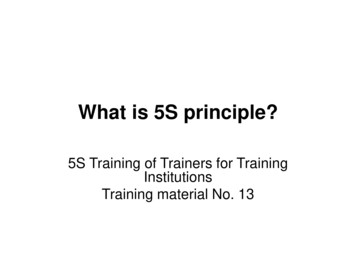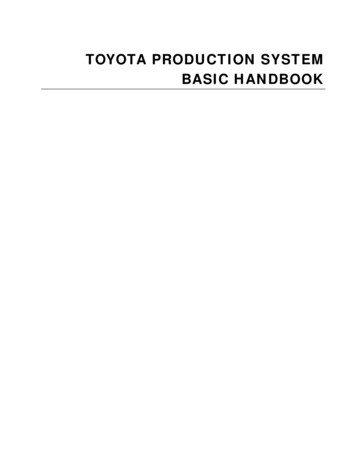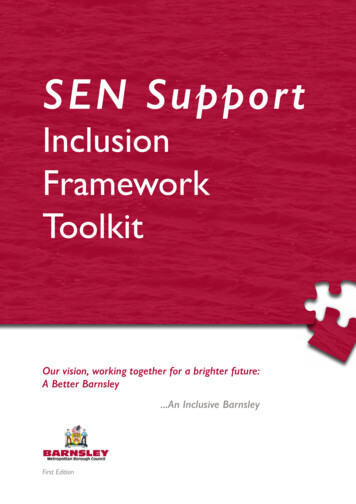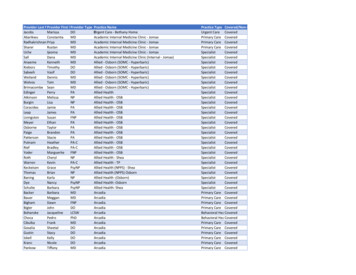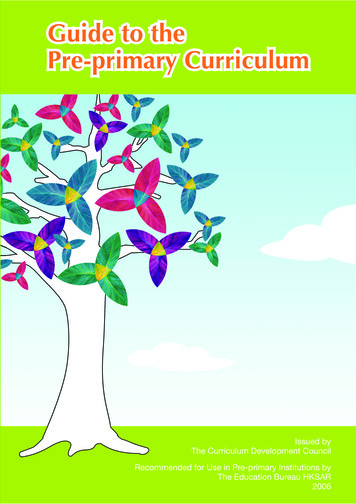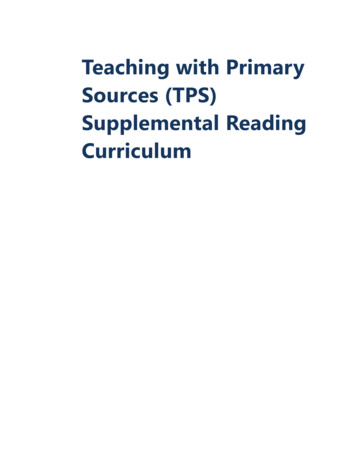
Transcription
Teaching with PrimarySources (TPS)Supplemental ReadingCurriculum
TPS Supplemental Reading CurriculumThis curriculum was developed as part of the Teaching with Primary Sources project atWilliam Paterson University (TPS at WPU). This project was sponsored in part by theLibrary of Congress Teaching with Primary Sources Eastern Region Program, coordinatedby Waynesburg University.Website: pu.dot?host id 1Page 12012-2013
TPS Supplemental Reading CurriculumTable of ContentsI.II.III.IV.V.Introduction to Primary SourcesUnderstanding the Research ProcessVocabularyParticipating in Literature CirclesAppendixPage 22012-2013
TPS Supplemental Reading CurriculumI.Introduction to Primary SourcesDescription:This unit will help students build literal, interpretive, and critical comprehension skills. The unitprovides students with an overview of the reading process; and opportunities to reflect ontheir own reading processes to improve their metacognitive abilities, to practice usingstrategies while reading, and to examine their interests and reading habits. The unit willprovide the opportunity for students to demonstrate their ability to make connections (placingemphasis on text-to-text and text-to-world), draw conclusions by synthesizing clues frommultiple sources, and generate and respond to insightful questions about texts across genre.The students’ written responses to texts produced throughout the unit, can be used to assesstheir comprehension. The unit can be introduced in a series of coherent sequential lessons orthe activities can be integrated with other reading units and lessons.By the end of the unit, students will be able to extrapolate information, summarize andsynthesize information from multiple sources to identify trends and patterns, drawconclusions, make inferences, demonstrate effective use of strategies for distinguishing mainidea from implied main idea, and use graphic organizers to extrapolate information from textsacross genres. Through collaborative and whole class discussions as well as writingassignments students will demonstrate understanding of author’s purpose. In order tocharacterize the attributes of individuals encountered in text, students will be able to discussand research characters/figures encountered in texts and analyze events and explain howthey impacted decision-making of various “figures” in texts in fiction and nonfiction. Students’analysis will demonstrate their ability to closely examine and make inferences aboutcharacters’ actions, motives, and traits. Students will also be able to make distinctionsbetween fact, opinion, claims, evidence, bias, and propaganda, and provide evidence tosupport arguments during oral presentations (such as debate) and in writing.Objectives:1. Understand what are primary source documents.2. Make observations and generate questions about a wide range of texts then discuss (insmall groups) their findings from their observations.3. Use note-taking strategies to practice summarizing skills.4. Read and analyze primary source documents.5. Participate in a cooperative groups to analyze various visual aids6. Analyze a text to infer implied ideas.7. Discuss the identifiers of tone and mood in a piece of text8. Revise their poetry by adding extended metaphors and the title of their piece.9. Introduce and deconstruct aspects of the reading process10. Identify, examine and use inquiry processes11. Identify and use reading strategies and skills12. Review steps for using clues from one or more sources to drawing conclusion13. Identify ways to use prior knowledge by making connections14. Identify strategies for summarizing and synthesizing information from different kinds oftextsPage 32012-2013
TPS Supplemental Reading Curriculum15. Review how to identify the main idea and supporting details in a text selection16. Review how to distinguish between a main idea and a topic17. Identify techniques for distinguishing between main idea and implied main idea18. Summarize and synthesize information from multiple sources19. Identify ways to use graphic organizers to extrapolate information from texts acrossgenres20. Identify author’s purpose21. Recognize point of view22. Review analysis procedures for identifying plot (events) and characters (figures) acrosstexts23. Distinguish between fact and opinion24. Distinguish and outline the difference between primary and secondary sources.25. Draw conclusions about “artifacts”26. Discuss using artifacts for research as archeologists.27. Classify various sources as primary or secondary (and if applicable tertiary).Student Learning Outcomes:Students will be able to:1. Apply active reading strategies while reading authentic texts.2. Identify elements of the reading process and discuss how to modify them whilereading.3. Use the inquiry process to closely examine and analyze texts across genres.4. Use varying reading strategies to comprehend fiction and nonfiction texts.5. Produce written and oral summaries that succinctly capture the main idea of textsacross genres.6. Use evidence from text to support main idea.7. Demonstrate ability to distinguish between main idea and topic.8. Demonstrate understanding of implied main idea.9. Synthesize information from multiple sources to identify common themes found ingraphic and printed texts.10. Draw conclusions by analyzing and interpreting information from different texts.Lessons:1. What is a primary source?2. What are some examples of primary sources?3. Use direct instruction to introduce inquiry model: “Analyzing Primary Sources”SCIM-C (attached)Teacher’s rces/guides.html4. Use pictures and other visual texts to model analysis techniques before demonstratingthe same process with written textsSuggested Pictures:Baseball: marysourcesets/baseball/Page 42012-2013
TPS Supplemental Reading CurriculumChildren’s Lives at the Turn of the Twentieth ials/primarysourcesets/childrens-lives/The Harlem als/primarysourcesets/immigration/The Chinese 0000/3c03000/3c03100/3c03143v.jpg5. Introduce and model active reading strategiesUse video clipsSummarizing: http://www.youtube.com/watch?v T7JAIMAw Es&feature relmfuVisualizing and Making Mental Images: http://www.youtube.com/watch?v -EX5XhbXiY&feature relmfuMaking Inferences: http://www.youtube.com/watch?v pF2KbEA5rDQVocabulary and Context Clues:http://www.youtube.com/watch?v Grj96ia HTU&feature relatedhttp://www.youtube.com/watch?v 9zodarCyV8I&feature relatedAsking and Answering Questions:http://www.youtube.com/watch?v RKPf2sfW7ck&feature related6. Use workstations to differentiate and provide additional practice7. Model how to identify clues and how to use them to draw conclusions8. Model how to brainstorm and connect to prior knowledge before, during, and afterreading9. Review three types of connections (text-to-self, text-to-text, text-to-world) – placeemphasis on text-to-text and text-to-world10. Review the reading process11. Introduce format for found poems; review literary devices and techniques used bypoets to enhance their work and engage the readerTeacher’s und Poetry erials/primarysourcesets/poetry/12. Model how to identify themes and patterns in text by synthesizing information fromdifferent sources13. Introduce graphic organizers that can be used to extrapolate the main idea andsupporting details from fiction and nonfiction texts14. Introduce analysis handouts and review SCIM-C analysis process15. Explain that interpretive comprehension means drawing conclusions from sources andanalysis of the conclusions drawn from different sources to determine the "big picture"or theme, or pattern/trend16. Explain differences between main idea and implied main ideaPage 52012-2013
TPS Supplemental Reading Curriculum17. Discuss strategies for interpreting patterns in charts and graphs18. Review elements of implied main idea and details that led to the generating a coreidea19. Model how to closely examine and compare images to history for accuracySee suggested list of pictures (above)20. Model how characterization techniques can be used to analyze historical figures what can we learn about the historical figure from the primary source or the text theyproduced?21. Explain the difference between claims, evidence, bias, and propaganda22. Review how to make an “argument”23. Build students’ background knowledge by tapping into current events and othercontemporary primary and secondary sources. While exploring the topics in the unit,have students locate current events and find example of present day primary sources(e.g. in reaction to Steve Jobs’s death to build prior knowledge and illustrate how toactivate prior knowledge, resources about Jobs can be utilized. For example, thevideo stream of his 2005 Commencement bs-061505.html and obituaries to buildbackground knowledge in order to practice interpretive comprehension skills such asdrawing conclusions and making inferences).24. Have students self-select a contemporary topic to explore in the news. They shouldlocate newspaper articles on the topic and practicing using the highlighter to identifymajor themes and clues that lead to conclusions and other interpretive skills andstrategiesActivities:1. Self-assessa. Complete formative assessment – Standardized reading comprehension testb. Complete “Survey of Reading Strategies” (Mokhtari & Reichard, 2002)c. Reading Interest Inventoryd. “Important Book and Literary Histories” (Tovani, 2000.) Students shouldcomplete this and give an oral presentation about its content.2. Read, Writing, Discussiona. Students will read a wide array of poems and examine their content for literarydevices and techniques.b. Students will read novels, speeches, historical fiction, newspaper articles, andshort stories.c. Students will locate multiple articles/sources (print and nonprint) on the sametopic and practice using reading strategies to compare and analyze the sources:highlighting, summarizing, synthesizing, noting details, making connectionsd. Students will use different kinds of graphic organizers to practice note-taking,extrapolate information from texts using before, during, and after readingstrategiesPage 62012-2013
TPS Supplemental Reading Curriculume. Students will use different document analysis techniques to closely examineprimary source documents and other nonfiction texts to consider such areas aspropaganda, bias, claims, and author’s purpose.f. Create found poemsg. Produce their own poems with and without extended metaphors and share theirpoems with the class.h. Participate in group discussions about details in texti. Use reflective writing to hone metacognitive, reading skillsj. Respond to metacognitive journal promptsk. Conduct research to prepare for class debatesl. Participate in class debates about controversial topics where they use evidencefrom different sources to make an oral argumentm. Students will work cooperatively to create a summary. Students analyzedifferent texts on the same topic, then discuss their findings and shareinteresting insights presented their texts.3. Practice skills – independent and small group work workstation tasksa. Use metacognitive journal prompts to respond to readingb. Graphic Organizers: SCIM-C, Mind mapping strategy for activating schemac. Practice using strategies introduced in classd. Use index cards with captions of pictures to determine the meaning of picturese. Distribute Whitman’s photograph along with his poem “A Noiseless, PatientSpider,” and a topic web. Then have students work in groups to use main ideaand details and write a summary paragraph. Students can conclude by workingin groups to summarize Whitman’s poem.f. Complete graphic organizers while reading different kinds of texts across genresg. Use KWL S organizer to generate research questions - practice developinggood “search” questions, and identify possible sources they would use werethey to conduct research. This will help students understand how they would goabout engaging in the research process but will not complete a research projectat this time.h. Review primary sources at each workstation and complete Primary sourcesanalysis handout to record/capture conclusions drawn while interpreting thetextsExamples of primary source documents for analysis at stations:Report of Canning Industry (original clc/resources/images/canneries3.pdfChild labor ("an awful bor.pdfPolitical CartoonsThe Political Cartoon for the Year /33531v.jpgAnalysis sheet for political urces/resources/Analyzing PoliticalCartoons.pdfPage 72012-2013
TPS Supplemental Reading Curriculumi.j.Generate questions using Bloom's Taxonomy stem startersUse text analysis handout to explore critical literacy/historical context genre,content - details and main idea, contextk. Double entry journal prompts - Journal entries that explores what theartist/creator meant when he or she created the images/documentsl. Review and complete worksheets that outlined the difference between primaryand secondary sources.m. Groups review “artifacts” to try to draw conclusions about them. Then discussusing artifacts for research as if they were archeologists.n. Classify various sources as primary or secondary (and if applicable tertiary)Assessment:1.2.3.4.5.6.7.8.Workstation tasksWritten responses to textsGive an oral presentation on a research topicComparative essay that makes connections between two documents.Oral presentation of original found poem or presentation of a published poemWrite and present a persuasive speech on a contemporary controversial topicReports/book talks (oral presentations)Quizzes – main idea and supporting details, inference, implied main idea, graphics(charts, graphs), fact, opinion9. In-class debate evaluated using rubric10. Teacher observation and questioningOnline/ Digital Resources: Baseball - listen to 1908 Version (Edison Recording) on YouTubehttp://www.youtube.com/watch?v q4-gsdLSSQ0;The Ball Game – Thomas apr:@field(NUMBER @band(awal 1317}))1900 Epic ls/lessons/1900america/preparation.htmlAlice Paul - Women's ials/primarysourcesets/womenssuffrage/pdf/teacher guide.pdfPolitical cartoons teacher’s s/primarysourcesets/politicalcartoons/pdf/teacher guide.pdfBreaker 1131v.jpgPage 82012-2013
TPS Supplemental Reading CurriculumAdditional Resources:See AppendixCommon Core Standards Addressed:CC.11-12.R.L.1: Cite strong and thorough textual evidence to support analysis of what thetext says explicitly as well as inferences drawn from the text, includingdetermining where the text leaves matters uncertain.CC.11-12.R.L.2: Determine two or more themes or central ideas of a text and analyze theirdevelopment over the course of the text, including how they interact and buildon one another to produce a complex account; provide an objective summaryof the text.CC.11-12.R.L.3: Analyze the impact of the author’s choices regarding how to develop andrelate elements of a story or drama (e.g., where a story is set, how the actionis ordered, how the characters are introduced and developed).CC.11-12.R.L.5: Analyze how an author’s choices concerning how to structure specific partsof a text (e.g., the choice of where to begin or end a story, the choice toprovide a comedic or tragic resolution) contribute to its overall structure andmeaning as well as its aesthetic impact.CC.11-12.R.L.6: Analyze a case in which grasping point of view requires distinguishing whatis directly stated in a text from what is really meant (e.g., satire, sarcasm,irony, or understatement).CC.11-12.R.L.7: Analyze multiple interpretations of a story, drama, or poem (e.g., recorded orlive production of a play or recorded novel or poetry), evaluating how eachversion interprets the source text. (Include at least one play by Shakespeareand one play by an American dramatist.)CC.11-12.R.L.10: By the end of grade 11, read and comprehend literature, including stories,dramas, and poems, in the grades 11–CCR text complexity band proficiently,with scaffolding as needed at the high end of the range.CC.11-12.R.I.1: Cite strong and thorough textual evidence to support analysis of what the textsays explicitly as well as inferences drawn from the text, including determiningwhere the text leaves matters uncertain.CC.11-12.R.I.2: Determine two or more central ideas of a text and analyze their developmentover the course of the text, including how they interact and build on oneanother to provide a complex analysis; provide an objective summary of thetext.CC.11-12.R.I.3: Analyze a complex set of ideas or sequence of events and explain howspecific individuals, ideas, or events interact and develop over the course ofthe text.CC.11-12.R.I.5: Analyze and evaluate the effectiveness of the structure an author uses in hisor her exposition or argument, including whether the structure makes pointsclear, convincing, and engaging.CC.11-12.R.I.6: Determine an author’s point of view or purpose in a text in which the rhetoricis particularly effective, analyzing how style and content contribute to thepower, persuasiveness, or beauty of the text.Page 92012-2013
TPS Supplemental Reading CurriculumCC.11-12.R.I.7: Integrate and evaluate multiple sources of information presented in differentmedia or formats (e.g., visually, quantitatively) as well as in words in order toaddress a question or solve a problem.CC.11-12.R.I.8: Delineate and evaluate the reasoning in seminal U.S. texts, including theapplication of constitutional principles and use of legal reasoning (e.g., in U.S.Supreme Court majority opinions and dissents) and the premises, purposes,and arguments in works of public advocacy (e.g., The Federalist, presidentialaddresses).CC.11-12.R.I.10: By the end of grade 11, read and comprehend literary nonfiction in thegrades11–CCR text complexity band proficiently, with scaffolding as neededat the high end of the range. By the end of grade 12, read and comprehendliterary nonfiction at the high end of the grades 11–CCR text complexity bandindependently and proficiently. By the end of grade 11, read and comprehendliterary nonfiction in the grades 11–CCR text complexity band proficiently, withscaffolding as needed at the high end of the range. By the end of grade 12,read and comprehend literary nonfiction at the high end of the grades 11–CCR text complexity band independently and proficiently.CC.11-12.W.1: Write arguments to support claims in an analysis of substantive topics ortexts, using valid reasoning and relevant and sufficient evidence.CC.11-12.W.2: Write informative/explanatory texts to examine and convey complex ideas,concepts, and information clearly and accurately through the effectiveselection, organization, and analysis of content.CC.11-12.W.6: Use technology, including the Internet, to produce, publish, and updateindividual or shared writing products in response to ongoing feedback,including new arguments or information.CC.11-12.W.8: Gather relevant information from multiple authoritative print and digitalsources, using advanced searches effectively; assess the strengths andlimitations of each source in terms of the task, purpose, and audience;integrate information into the text selectively to maintain the flow of ideas,avoiding plagiarism and overreliance on any one source and following astandard format for citation.CC.11-12.W.9: Draw evidence from literary or informational texts to support analysis,reflection, and research.CC.11-12.S.L.1: Initiate and participate effectively in a range of collaborative discussions(one-on-one, in groups, and teacher-led) with diverse partners on grades 11–12 topics, texts, and issues, building on others’ ideas and expressing theirown clearly and persuasively.CC.11-12.S.L.2: Integrate multiple sources of information presented in diverse formats andmedia (e.g., visually, quantitatively, orally) in order to make informeddecisions and solve problems, evaluating the credibility and accuracy of eachsource and noting any discrepancies among the data.CC.11-12.S.L.3: Evaluate a speaker’s point of view, reasoning, and use of evidence andrhetoric, assessing the stance, premises, links among ideas, word choice,points of emphasis, and tone used.CC.11-12.S.L.5: Make strategic use of digital media (e.g., textual, graphical, audio, visual, andinteractive elements) in presentations to enhance understanding of findings,Page 102012-2013
TPS Supplemental Reading Curriculumreasoning, and evidence and to add interest.Page 112012-2013
TPS Supplemental Reading CurriculumII.Understanding the Research ProcessDescription:This unit will introduce students to a few techniques for close reading and analysis of print andnon-print texts, which can serve as sources during the research process. The lessons andactivities will scaffold students through the research process with a focus on selecting,analyzing and evaluating sources, comparing sources, note-taking, summarizing andsynthesizing, and citing sources. Students will complete independent research on a selfselected topic that demonstrates critical examination. Techniques introduced during the unitwill provide students with a strong foundation to provide high quality research papers thatreflect those expected in college.Objectives:1.2.3.4.Review different techniques for identifying, selecting, and evaluating sourcesReview techniques for organizing and conducting researchReview different techniques for evaluating and deconstructing textUnderstand the importance of closely analyzing a source and how locatingcorroborating sources can help to problematize an issue under investigation5. Use note-taking strategies to practice summarizing skills6. Use appropriate formats for in-text citations of text and references7. Analyze cause and effect, cultural context, main idea and supporting details8. Assess comprehension and interpretation in informational text9. Determine the meaning of words and phrases as they are used in a text10. Compare and contrasting world views11. Evaluate credibility of sources, including influences of bias and author’s purpose12. Make inferences and predictions about different kinds of texts and how they canbe used during each phase of the research process13. Establish and maintain a formal style and objective tone14. Review and discuss copyright information and strategies for avoiding plagiarism15. Examine how placing texts within a historical or social context impacts themeaningStudent Learning Outcomes:Students will be able to:1.2.3.4.5.6.Select at least 1 technique to apply to their historical researchSelect at least 1 technique to apply to their senior research paperClosely examine sources and practice using the techniques introducedProduce a clear thesis statementProduce clear and coherent writingWrite informative/explanatory texts to examine and convey complex ideas,concepts and information during expository writing7. Use a wide variety of online and digital tools to conduct researchPage 122012-2013
TPS Supplemental Reading CurriculumLessons Taught:1. Model how to conduct an online search, use ‘think aloud’ to demonstrateprocesses for determining which websites and sources to use2. How to make distinctions between online sources3. Review tips for selecting a “researchable” topic, narrowing the topic, andgenerating a thesis statement or research question based on the topic4. Scaffold students through analysis of different kinds of sources and how todetermine the usefulness of print and nonprint texts when addressing a researchquestion5. Discuss the importance of evaluating resources and how important it is to identifystrengths and weaknesses in sources during the selection process and whenconducting research (point out that students should note the limitation of sourceswhen writing or presenting their research)6. Review how the process of deconstruction and analysis can transfer across texts7. Introduce techniques for conducting research8. Review research processes and the sources used to examine different topicsActivities:1. Rank the sources provided based on their “trustworthiness” and usefulness in anhistorical investigation2. Watch the video – “Why Historical Thinking /a) Before watching the video students will review primary source documents anddetermine how they approach the analysis process. They will generate aseries of steps used during their process that they think can be used with anysource. In the margins, have students jot down what they notice in thedocuments. Then they can turn and share their “noticings” with a partner.b) Explain that they will listen and watch a video as historians analyze sources.During the video students will learn how historians use a multi-layeredprocess of Sourcing, Contextualizing, Close Reading, and Corroborating(using sources as evidence to answer questions) to approach the same task.c) After the video lead students in discussion of how the processes used in thevideo can be applied to any research process.3. Introduce students to the SCIM-C process.a. Explain that sometimes researchers have a question or hypothesis in mindwhen they begin the research. Other times, the research process beginswith an examination of sources that will then LEAD to questions that canbe used for research.b. Guide students through the SCIM-C graphic organizer. Begin by placing aphotograph on the overhead and walk through the process together.During the “monitor” step of the graphic organizer help students generatePage 132012-2013
TPS Supplemental Reading Curriculum4.5.6.7.questions about the source. During the “corroboration” step studentsshould identify possible sources where they can go answer their researchquestions and verify information from different sources.Each student will read a newspaper article on the same topic. Distribute onenewspaper article to every other student (the person sitting next to them will reada different article). In partners students will provide a brief summary of theirarticle and then discuss the following questions- What conclusions are drawn in the article about the events that took placeand how is information being corroborated?- What limitations do you see in the sources used to corroborate the events?Review the handout, “Guide for Evaluating Articles and Resources,” with theclass and then ask students to connect back to the newspaper article they readfor the previous activity.Practice skills – independent and small group work workstation tasksa. Work in small groups or partnerships to examine sources (or excerpt froma novel or other text) to complete a SCIM-C graphic organizer. Uponcompletion, students share their findings with the class. Then whilesharing their findings, the class they will reflect on how this protocol canhelp them closely evaluate sources for their value to the research process.b. Work in small groups to examine and compare two different kinds of texts.Use the “Deconstructing Media” handout to review 2 audio recordings onthe same event (using an iPad or laptop to go online). Students shouldnote disparities between the sources and generate some plausibleexplanations for the differences.c. Students will locate online videos (e.g. commercial, YouTube etc.) andevaluate them using the “Deconstructing Media” handout. Students willshare the video with the class and explain their analysis using thedeconstruction framework.Students review 2 sources: 1 audio recording and interview transcript of FlorenceThompson, “Migrant Mother” http://www.ganzelgroup.com/movies/thompson.htmland the other text is a collection of photographs taken by Dorothea LangeCollection of “Migrant Mother” http://www.loc.gov/rr/print/list/128 migm.html.Students’ analysis should examine how the two women met – How did their livesintersect? Students should examine how the 2 women walked away from theirmeeting with different understandings/perspectives of their meeting. In smallgroups or in a whole class students can use the following analysis/discussionquestions to examine the sources for reliability:a. What is the perception of the meeting described by each woman?b. What might account for the differences in their accounts? Students shouldbe advised to read the captions of all photos. Consider the tips: situatethe text in a time- historically, what was going on at that time in Americanhistory, what story is the best one for Dorothea Lange to tell, what is theauthor’s goal, bias, or stance.c. What are the strengths and limitations of each of the sources?d. What questions arise about the sources?Page 142012-2013
TPS Supplemental Reading Curriculum8. Students visit the library to conduct research reports on famous personalitiesfrom the students’ self-selected topic.9. Read/ model using Poe’s, The Tell Tale Heart, and O. Henry’s, The Ransom ofRed Chief, and wr
TPS Supplemental Reading Curriculum Page 1 2012-2013 This curriculum was developed as part of the Teaching with Primary Sources project at William Paterson University (TPS at WPU). This project was sponsored in part by the Library of Congress Teaching with Primary Sources Eastern Region Program, coordinated by Waynesburg University.
